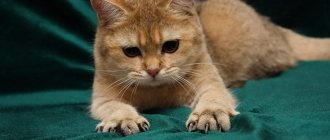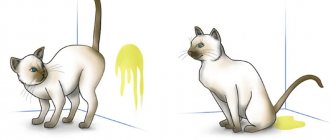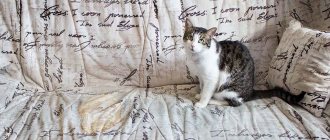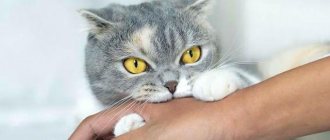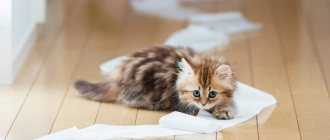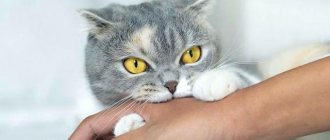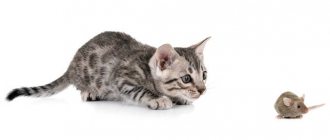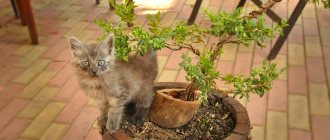Cats are affectionate and graceful animals that create coziness and a feeling of peace in the apartment. After a hard day at work, it’s nice to play with your pets or just listen to their purring. But, despite all these advantages, cats can cause a lot of trouble for humans. Their habit of sharpening their claws on the sofa can infuriate even the most loving owner. To keep upholstered furniture intact, you need to understand why the animal behaves this way and gradually wean the cat from tearing up the sofa.
Why do cats tear up furniture?
In the wild, this behavior is absolutely normal for cats. Lions, lynxes, pumas and cheetahs sharpen their claws on trees and stumps, thereby marking their territory. In addition, this procedure in animals is aimed at maintaining hygiene.
Pets serve slightly different purposes. They scratch furniture not to mark the boundaries of the territory and not for entertainment, but in order to give themselves a “manicure”. Attentive owners often notice the top layer of claw on the floor or sofa, and the animals try to get rid of it. Thanks to this method, the claws retain their sharpness and health.
If a cat is upset, scared or angry about something, then in this way he can relieve stress or attract the attention of the owner.
When a cat lives in a small apartment, this is also an excellent workout for all muscles. Therefore, if a cat tears up a leather sofa, you should not think that she did it on purpose. Some individuals release their negative energy in this way.
Domestic cats always have a hunting instinct. And on the couch they sharpen not only their claws, but also their skills. Thanks to this training, the animal learns to alternately release its claws and improves its skill.
Recommendations
The re-education process requires a lot of patience. The owner needs to remain calm and try to stop the cat from tearing up the wallpaper. It doesn’t matter what state the cat has brought you to. Keep calm and never do:
- Trim your kitten's nails yourself.
- Do not use corporal punishment as a preventive measure.
- Don't throw away your old scratching post. It’s better to update it with improvised means. Cats perceive anything new with caution.
- Cats sharpen their claws after sleep or when they go to meet their owner. Place the scratching post at the front door, next to the bed.
- To attract the animal's attention to the scratching post, hang feathers or toys. Cats easily accept new rules if they are presented in a playful way.
- After purchasing a scratching post, you need to protect all previous places of vandalism, blocking access to them. Place sandpaper or rustling foil near your favorite spots.
Don't scold your cat for sharpening his claws. This is his natural need. It is better to reward your pet when he uses the scratching post. Perseverance and love can instill new norms of behavior in a cat. Don't ruin your relationship with your pet. Use the advice, be patient, and the result will not be long in coming.
scratching post
The simplest and most harmless way is to buy a special device - a scratching post. They come in different types: horizontal and vertical, large and small, expensive and cheap. Among such variety, you can always find the right thing for a specific pet. But it’s not enough to just buy a scratching post; the most important step is to teach your cat how to use it.
When a person decides to get a pet, it is better to purchase a scratching post before the cat gets to the furniture. In addition, it is much easier for a kitten to explain what its owner wants from it than for an adult. To do this, you need to bring your pet to the scratching pad several times a day, as well as every time you try to ruin the sofa, and place your paws on its surface. In a few days the animal will understand what's what and will stop terrorizing things.
If this does not happen, then the cat can be driven away from the crime scene by slightly raising your voice or using a spray bottle with plain water. And when she uses the purchased scratcher herself, you should definitely praise her and reward her with something tasty.
Effective ways
It is not easy to stop a cat from tearing furniture and wallpaper if it has already become a habit. Some owners prefer to change the type of wall and floor coverings. For example, cats are indifferent to plastic panels, ceramic and PVC tiles, high-class laminate, artificial stone and decorative plaster.
Some people prefer to cover upholstered furniture with thick fabric upholstery.
However, we must understand that even replacing the coating or an alternative to it will not be able to permanently wean the cat from scratching its claws and gnawing objects. This process is natural and vital. Therefore, you will have to not only wean yourself off, but also think about how to switch your attention to other subjects.
Let's consider the most effective methods of protection.
Repellent odors
You can try to wean your pet from a bad habit by treating his favorite scratching areas with a product with an unpleasant aroma. It is known that cats do not like the citrus smell, so this is worth taking advantage of.
This can be orange, lemon peel or essential oil.
However, oil is inconvenient because it leaves unsightly greasy stains on the surface. An alternative to citrus, ether or spray can be some spices (for example, coriander or chili), which can be used to treat some surfaces (not suitable for furniture on which a person sits).
Protective coatings
You can save the upholstery of a sofa and armchairs by using covers made of special fabric or so-called anti-vandal Euro covers. In specialized stores you can choose options with a coating that is too tough for cats and not for their claws.
They simply will not be able to stick their claws into the fabric.
Trimming and nail trims
You can stop your cat from scratching the upholstery and damaging the surface of the wallpaper in a more effective way by cutting the claws or gluing special plastic covers on them. To trim claws, purchase a special device - a nail clipper, literally cutting off 1-1.5 mm of the regrown length.
The device is quite convenient and allows you not to stretch out the procedure, and therefore the cat does not have time to get nervous.
The pads are put directly on the claws, having previously lubricated them inside with special glue. Don't worry too much about it being harmful. As practice shows, the glue is not so strong, but for some time the cat will not be able to damage the furniture upholstery and wallpaper.
Alas, at the same time she will not be able to retract her claws, and it will be difficult for her to jump, but she will still be able to provide temporary protection to objects.
Pulverizers and sprays
To prevent your cat from sharpening its claws and teeth on furniture, wallpaper and curtains, you can try using a spray bottle. Scaring can have an effect on individual individuals if it is done at the moment when the animal is tearing upholstery fabric or wallpaper.
You can also spray your favorite items with a special spray to repel your pet. Citrus-scented sprays are repulsive to some cats.
Available means
You can protect furniture and wallpaper using another method. For example, favorite places can be covered with sticky, sliding or rustling material on top. For example, stick double-sided tape or foil to the torn area of the wall.
Some people prefer to create a scaring noise when the cat sharpens its claws. To do this, use baby rattles or a bunch of keys.
scratching post
A special device for sharpening claws is an excellent and effective way to save both furniture and wall cladding. It can be either an individual item or part of a play complex for a cat. Its shape can be very diverse, as well as its material.
Cats like large play complexes, because this is their territory where they can spend a lot of time. And this allows you to save the owners’ upholstered furniture.
Equipment for a personal sleeping area
To prevent your cat from tearing up furniture and wallpaper, it is recommended to make a personal place for him to sleep. This will reduce the animal's stress if people have multiple pets. You can use special houses, sun loungers or ordinary cardboard boxes.
You need to choose a suitable space for installation and accustom the cat to it using training or aromatic substances (mint, valerian).
It is recommended to place the pet's house near a place where people are often present, since cats love company and rarely tolerate loneliness. It is necessary to wean other animals from trying to occupy someone else's house and equip a separate one for each.
This will reduce the number of stressful situations for cats and help prevent property damage.
Wallpaper protection
If an animal scratches wallpaper or furniture in one place, then you should get fabric covers. They are easy to attach to the surface using nails, glue, and paper clips. The damaged area can be covered with adhesive tape. It is subtle, but effective against cats, as they really don’t like it when something sticks to them.
You can also use a woven cotton rug that is attached to a wall or furniture. It, like fabric, will allow your pet to sharpen its claws without damaging interior items.
It is recommended to choose liquid, slippery wallpaper or replace old ones with them. This way, the cat will have nothing to cling to, and it will stop tearing at the wall. The most drastic solution may be to cover the damaged areas with tiles or decorative plaster.
If all else fails
If water and a scratching post do not solve the problem, you will have to think about how to stop your cat from scratching furniture, using more serious methods. You can use special silicone attachments for animals. They are attached to the claws with an adhesive substance and last from 1 to 2 months. After the upper horny part of the cat's toe peels off, the pad falls off along with it.
An alternative to silicone devices is surgical declawing. This procedure is not recommended for use as it is similar to amputating a human finger and is not humane.
You can also protect items from the kitten using covers. They are similar to fabric covers that are attached to the surface, but cover the entire furniture or a separate part of it. If a cat is tearing at an element of the interior, it is recommended to use a spray with a strong repulsive odor.
You can find it at a veterinary pharmacy or prepare it yourself.
This substance has an unpleasant aroma for cats and can discourage the animal from any furniture. You can mix essential oils, spices, citrus juice with water, or hang bags of spices near the problem area.
This method is not always suitable, since the listed substances emit an unpleasant aroma for humans and can also leave streaks and stains.
Silicone claw tips
Silicone claw covers are a new way to protect your sofa. The method is quite expensive and not very convenient; it is better to carry it out with an experienced specialist. He applies attachments to each claw with glue and neutralizes them. Such covers will have to be changed once a month, and after each procedure you will have to do a manicure and file your claws.
This method is not suitable for pets with allergies, as the glue used may cause an unwanted reaction. In addition, in order to wean a cat from scratching the sofa using this method, you need to have nerves of iron, because not everyone can listen to the endless clicking sound that the caps make when they touch the floor.
Manufacturers claim that the procedure is completely safe and claim that anti-scratch products do not cause any inconvenience to the cat. In fact, this is not entirely true, because it is the claws that make the animal dexterous. With silicone covers on them, the cat runs the risk of falling even when playing on the floor, not to mention the fact that she can easily get injured when jumping from a height.
The animal often experiences discomfort and even pain, as it cannot retract its claws. With splayed fingers, a cat is unable to scratch and wash itself normally. She may also try to chew off the irritating elements with her teeth and, in the worst case, swallow them.
To avoid causing your pet so much inconvenience, you should educate him from an early age.
Why do cats sharpen their claws?
Cats that walk outside wear down their claws by climbing trees or rocks. Cats kept at home tear wallpaper to remove overgrown claws.
Reasons why cats tear upholstery and wallpaper:
- the instinct of self-preservation;
- territory label;
- stress relief.
A cat's claws are a means of attack, defense, and a means of climbing trees and rocks. Instinct forces a cat to maintain its claws in proper condition: always sharp.
The pads of a cat's paws secrete special substances (pheromones), which, like the secretion of the anal glands, help mark the territory of a predator. When a cat tries to tear off the wallpaper, it thus marks the house in which it lives.
Just as a person needs a nervous release, a cat needs to satisfy his instincts if he doesn’t like something or someone has offended him. A reinforced point of the claws in a favorite place helps the cat “unwind” the cat. By scratching the wallpaper or the side of a chair with its claws, the pet gets rid of psychological discomfort. Sometimes cats under nervous stress chew off their claws. Older cats stop looking after their claws. The owner of the animal must ensure that the claws do not grow into the pads.
© shutterstock
Sprays
Special sprays sold in pet stores can help stop a cat from sharpening its claws on the sofa. They have a pungent odor that cats cannot stand. At least that’s what the manufacturers say, but in practice, this doesn’t stop some individuals at all.
Resourceful pet owners use an analogue of such sprays. To do this, add a few drops of orange oil to a spray bottle with water and spray the resulting mixture onto the furniture. Cats can't stand the strong smell of citrus fruits, so this should help protect your couch. Under no circumstances should you splash such water on your cat; it can get into its eyes and cause serious damage to its health. You can treat the sofa with undiluted oil, in inconspicuous places. This will scare away even the most annoying pets.
Tips: how to stop a cat from tearing up the sofa and wallpaper
The cat does not tear the wallpaper around the entire perimeter of the room. As soon as the favorite locations are “re-marked”, the pet’s attention will focus on the scratching post, and the cat will wean itself from scratching wallpaper and furniture.
Plants
Freshly picked herbs and ornamental plants repel animals. Suitable for these purposes:
- mint;
- rue;
- rosemary.
Fresh plants in small cannons are tied up in those places where the cat is tearing up furniture. Small bags or sachets containing chopped herbs are also suitable. Cats also do not like the smell of citrus fruits and ground allspice.
Traditional methods and homemade liquids
Homemade sprays can also help stop your cat from scratching furniture. For 50 ml of clean and soft water you will need:
- 3 drops of essential oils, otherwise stains will remain on the furniture when it dries
- citrus peels or juice (optional orange, lime or lemon);
- lavender.
Before spraying, shake the aromatic water and treat the surfaces.
If you add liquid soap to the composition, the smell will last longer, and the product can be smeared or sprayed on furniture.
Here are a few recipes that will help scare a cat away from wallpaper and furniture:
- 1 part citrus peels and 4 parts water. Cook over low heat for 20 minutes. Cool, spray the areas where the animal sharpens its claws on the wallpaper.
- Water mixed with vinegar in equal proportions, with the addition of colorless liquid soap, becomes a means for treating wooden surfaces in the apartment.
A little product is applied to the surface. In order not to remove stains from furniture later, do not forget to check how paints and varnishes react to vinegar.
We use ready-made products
Industrial sprays with an atomizer (for example, “Smart Spray”, “Stop Zone”) irritate the receptors, causing a burning sensation. A one-time effect of the product is designed for a week, then the treatment is repeated. Tip: Wear gloves when handling surfaces.
Getting used to the scratching post
Wall-mounted and free-standing scratching posts are a compromise solution: let the kitten scratch in one place. Models on sale differ in size, decorativeness, base coating and chemical applied for quick training.
The simplest option is to do it yourself. The board or pipe is coated with glue and tightly wrapped with twine, multi-colored sesame cord and leaned against a wall or furniture.
To train a cat, press on its paws, releasing the claws, and move them several times, praising the animal. Immediately give a little treat (cheese, sausage, boiled meat).
Who is more important: psychological methods of influence
In the most severe cases, the owner's mark will help. To prevent the cat from tearing the wallpaper, apply a drop of your own urine above the place on the walls where the cat scratched or tore. If at the same time you place a scratching post with the mark of another animal, the cat’s attention will focus on the new object. The following will also help you wean yourself from scratching wallpaper:
- sharp loud sounds (clapping hands, falling bunch of keys);
- spraying with water from a spray bottle;
- A gentle tap on the ears is appropriate if the kitten scratches the furniture in front of the owner.
This is how the reflexive connection “scratching the wallpaper and furniture in the room is scary” is formed.
Declawing
Some breeders choose complete declawing as a solution to the problem. This is a cruel and unreasonable option that leads to injury and even death of the pet. No conscientious and sensible veterinarian would suggest performing such a procedure if there is no medical indication for it.
The “soft paws” operation turns the animal into a disabled person, because when removing the claws, the veterinarian also removes part of the finger. The cat will easily lose its balance and fall off any surface, which will most likely lead to injury. If such a pet ends up on the street, runs away or gets lost, it will die very soon. Since with impaired posture and coordination of movement, he will not be able to run away from dogs or evil people. He will also be unable to defend himself from other cats without his claws.
The operating process also has its drawbacks, for example, general anesthesia, which animals can hardly tolerate. The operation itself is complex and unpredictable, and bleeding may begin during it. If the procedure is performed by an incompetent doctor, then there is a possibility that ingrown claws will appear. The roots will grow inside the foot, causing your pet severe pain.
One of the advantages of such an operation is that the cat will really no longer tear up the furniture.
Reasons why a cat scratches furniture
First, you need to consider the reasons why your four-legged friend decided that the furniture could be damaged.
- Nail sharpening is extremely important for cats because it is not only important to keep the claws in good condition, but also because it is an exercise aimed at strengthening the muscles;
- Fluffies express their emotional state in this way;
- This process is also necessary in order to mark its territory, since there are sweat glands on the paw pads, they leave an odor;
- If your pet scratches a piece of furniture that you use most often, then he may simply be expressing his love and, again, marking you, showing that you belong to him;
- This is a simple necessity that will not be affected by anything, not even your screams.
You just have to get creative if you want to keep the fittings in your home safe and sound.
